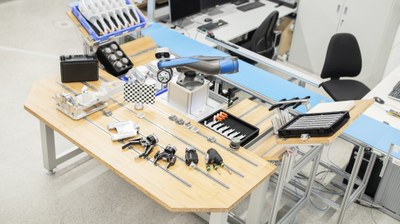Production in a net of robotic agents
Robotic agents, which autonomously arrange and process operating resources, tools, assemblies and components, are essential in the networked autonomous production. To break up rigid process structures, all components must be modularized, i.e. equipped with standardized interfaces and made transportable. Depending on the component size, transport can be carried out by AGVs (Automated Guided Vehicles) or ATVs (Automated Track Vehicles) in bowing or loading mode, or the components can be moved from place to place via bus systems, such as conveyor belts with bidirectional running directions and switches. The robotic assembly agent also plays an important role in the transport of components, as it has access to all the storage positions it needs for production.
All containers, desktop devices and fixtures required in the work area must be equipped with a reliably positionable and, if necessary, lockable mechanical interface, and must be able to be supplied via standardized interfaces that can be coupled by robots. In addition, tools for transporting these components must be provided so that they can be moved according to plan.
For this concept, the DLR Institute of Robotics and Mechatronics is developing robotic agents (DLR SARA) and ATVs (SwarmRail) in addition to the interfaces described above.

The sequence of production is described in individual steps, which follow a logical sequence, as well as input and output conditions. An AI can now calculate for a given batch size an optimal combination of steps across multiple stations, in which the production steps are executed. The optimization goal is the shortest possible throughput time of the order on as few stations as possible.
Required tools, components, devices and aggregates can be individually commissioned to process the order completely autonomously. A superimposed resource planning system can now plan the distribution of production resources, such as tools and sensors, over the entire network of the plant and thus ensure optimum utilization of the entire production network.
